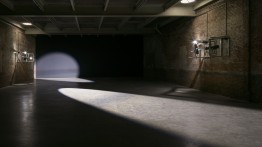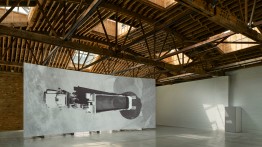Concrete and Light
POSTED ON: December 9, 2021
Two installations by artist Lucy Raven, associate professor in The Cooper Union’s School of Art, are currently on view at Dia Chelsea through the end of December. The exhibition—the first since the space reopened this year following an extensive renovation—is the culmination of Raven’s three-year engagement with Dia, featuring kinetic light sculptures from her Casters series (2021) as well as a new film, titled Ready Mix, which was named in a recent ARTnews survey as one of the defining artworks of 2021. Together the projects address perception and depictions of landscapes, infrastructure, and historical myth, particularly in relation to the American West.
“I’ve frequently made work in the Western United States—Utah, Nevada, Idaho, New Mexico, California,” says Raven, who was born in Tucson. “Moving to New York from Arizona, I was struck by the way that part of the country, from this perspective, seemed to resolve in images, rather than space. That discrepancy between a flat image—often of an open, spacious horizon suggesting the fantasy of an empty frontier—and the actual experience of what, and who, populates and fills the West, has been an ongoing source of provocation over the years.”
In one gallery, Raven’s Casters installation greets visitors with two pairs of moving light sculptures, each consisting of lights set in custom-built structures inspired by rotocasters, machines that rotate on multiple axes to mold three-dimensional objects. The choreographed movements of light across the gallery space—functioning as both searchlight and spotlight—draw on the artist’s longstanding interest in uses of optical technologies. In the adjacent gallery, projected onto an enormous screen, Ready Mix features 45-minutes of black-and-white footage filmed over the course of two years at a concrete plant in central Idaho.
“Concrete film is a term that doesn’t really exist, but I was interested in thinking about why not, what it might mean,” Raven explains. “In some ways, Casters has more to do with a tradition of concrete artworks, such as poetry or photography, in that it connects to a history of light in motion rather than the presentation of successive moving images on a fixed screen. Then I visited an actual concrete plant. It belongs to a friend in Idaho, where I spend a lot of time, and I asked if I could visit.”
Ready Mix is presented in an immersive, extra-wide aspect ratio and looks to extractive processes, changing states of fluidity and solidity, and the production of ready-mix concrete as a material substrate. “I was so taken with concrete as a material that on one hand is ubiquitous worldwide, and on the other has a very specific relation to the geography where it’s produced,” the artist says. “Concrete is made using cement, water, and gravel, which usually comes from a gravel plant nearby. We think of it as hard and immutable, but as a material it has no structural integrity until it hardens. It has to borrow its form from a shape it’s poured into. In that sense, it’s the physicalization of negative space. I started thinking about the development of the West in relation to its infrastructure—the monuments, including highways and dams, that paved the way for mass migration from the East, and the various ideas of negative space that fueled them. To me, the film is a Western.”
Raven says producing these works for a solo exhibition in Dia’s newly refurbished galleries afforded her the time and opportunity to fine-tune lighting for the film installation and to work out the choreography for Casters. “It was a wonderful and unique opportunity to be able to engage with Dia on these two commissions while they were finishing renovations of their Chelsea space,” she says. “The new renovation is very generous, understated but precise. The team I worked with at Dia are all those things, too, and it was working with them that made the exhibition possible.”
Lucy Raven is currently on view at Dia Chelsea through December 30, 2021.








